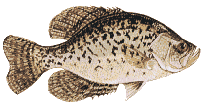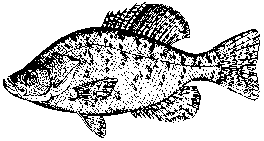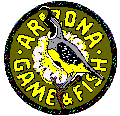|
In Arizona's White Mountains we've got Crappie too!
Angler's both young and old enjoy year around
fishing in the White
Mountains. Crappie are just one of the many species of fish available to the
avid fisherman! In Arizona, anglers may take fish by one line with hooks or
artificial lures. Purchase of a "two pole"stamp on Arizona's
fishing license allows anglers to fish simultaneously with two poles.
Fishing in Arizona is governed by Arizona State Law. A valid
fishing license is required. Licenses may be obtained from the Arizona Game
& Fish Department or any authorized vendor.
 Black Crappie Black Crappie
(Pomoxis nigromaculatus)
World Record: 4 lbs. 8 oz.
Arizona Record: 4 lbs 10 oz at San Carlos Lake in 1959
Description: Non-native to Arizona, Black Crappie were introduced to Arizona in
the 1905. The head and back are heavily and irregularly spotted with black
blotches on a silver-olive background; Tail, dorsal and anal fins are spotted.
Seven or eight spines on dorsal fin. Body is compressed or flat. Length: 6-12
inches. Weight: 3 oz. to over 4 pounds.
Location & Habitat: Black Crappie are far more abundant than
white crappie and are found in most of Arizona's major warmwater reservoirs.
Black crappie (and White crappie) are attracted to submerged brush and trees
and generally travel in schools. Spawning is often in open water, typically
over mud, sand or gravel bottoms. Males guard the nest, and young after the
eggs hatch. Generally mature in second or third year of life, rarely live more
than 6 to 7 years.
Food habits: Insect and plankton eaters until they reach four or
five inches switching to a fish diet. In Arizona, threadfin shad are their mail
diet.
Angling: Effective bait and lures are minnows, small jigs, silver
spoons, spinners and flies fished along shorelines and around submerged brush
piles and fallen trees.
Table Quality: The meat is white, fine textured and tasty.
 White Crappie White Crappie
(Pomoxis annularis)
Description: Non-native to Arizona, White Crappie were introduced
to Arizona in the 1960. The body is silver-white, 4 to 7 dark horizontal lines;
Lines below lateral line often faint and broken. Dorsal fins are distinctly
separate, unlike the yellow bass, which are joined at the base. 2nd anal spine
distinctly shorter than the 3rd. Lower jaw protrudes beyond upper jaw;
Generally a single patch of teeth at base of tongue. Length: 8 to 19 inches.
Weight: 5 ounces to 4 pounds.
Location & Habitat: Found only in Imperial Reservoir on the
Colorado River and Lake Pleasant. Prefer clear, open waters. Spawn in large
groups, in April or May, generally over rocky or rip-rap type areas.
Food: Main diet is threadfin shad. Hungry white bass will often
pursue schools of shad, causing the shad to jump and "boil" the surface of the
water in their frantic efforts to escape.
Angling: Effective lures are spinners, spoons, jigs and shad type
crank baits. During a feeding frenzy, they will strike practically any shad
imitating lure tossed into their midst.
Table Quality: The meat is white, firm, flaky and good eating.

Information & photo's courtesy ArizoInformation
& Photo courtesy Arizona Game & Fish Department. Published with the
permission of: Arizona Game & Fish Department Region 1, Pinetop. HC 66, Box
57201, Pinetop, AZ 85935, (928) 367-4281. If you would like to visit the home
page for the Arizona Game & Fish Department, you may find the Department at
www.gf.state.az.us.
|

